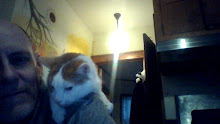A Review in the form of 25 Quotations

from
HALF
OUT
WHERE
by
Joseph Aguilar
(Caketrain,
2014)
1 “The stepfather drools in the rain. The rain
is magic.”
2 “By the sea we all hug.”
3 “A question cleans my face.”
4 “I hold a small fire in my hand.”
5 “My piano plays so soft you can sleep on its
teeth.”
6 “The stepfather cracks a gasket.”
7 “My beard upsets the baby.”
8 “The rabbit plays a hand shadow on the wall.”
9 “We were brambles.”
10 “My brother fouls my
necktie.”
11 “We thrust wildly
toward logic.”
12 “My liver hurts.”
13 “Everyone deserves
chemicals.”
14 “I saw it waiting in
the hospital.”
15 “Kneel with a bird in
the throat.”
16 “I forgot the old
ideas.”
17 “I rappel through a
current of honey.”
18 “In our new country we
make tiny burials for our vehicles.”
19 “I fell asleep
forgetting recipes I never knew.”
20 “We had to take the dog
to a country hospital here.”
21 “What happened?”
22 “I have pressure in my
bladder.”
23 “I start the car.”
24 “A fat one straddled
its egg in the web’s center.”
25 “I was watching only a
body yielding to what would carry it it to its end.”
Joseph Aguilar teaches
at the College of Wooster and has published widely in numerous small press
publications.
Half Out Where
can be purchased here:
http://www.caketrain.org/halfoutwhere/
Half Out Where
can be purchased here:
http://www.caketrain.org/halfoutwhere/

